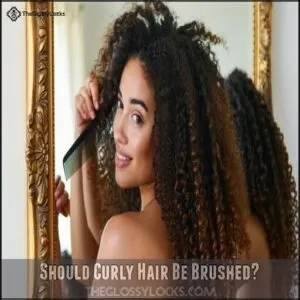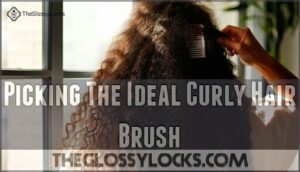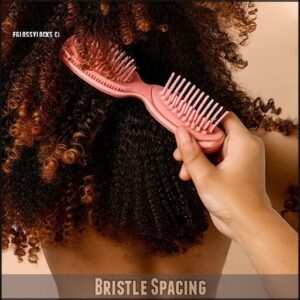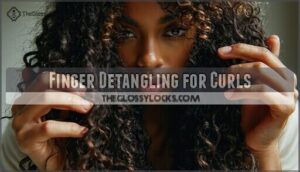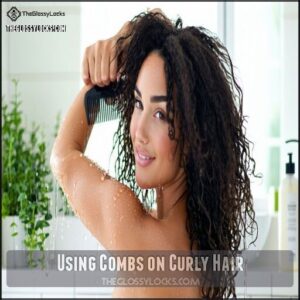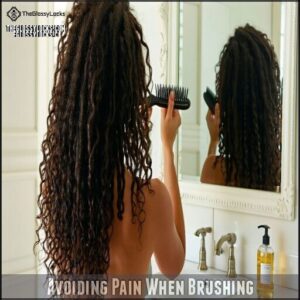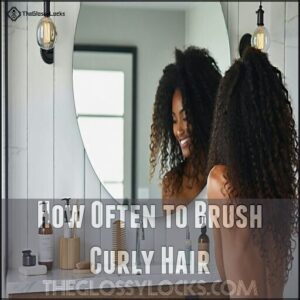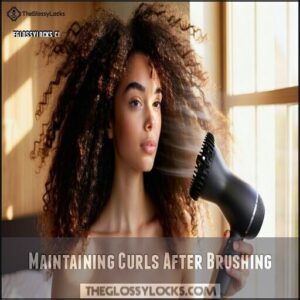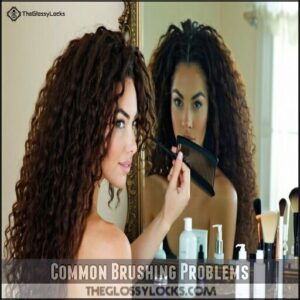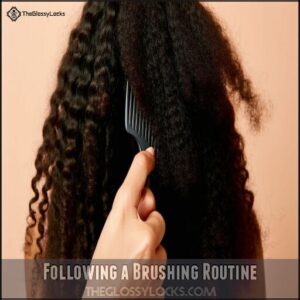This site is supported by our readers. We may earn a commission, at no cost to you, if you purchase through links.
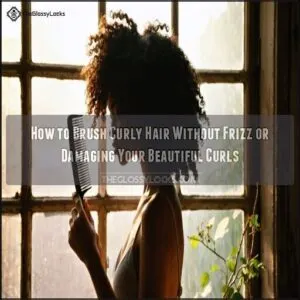 Brushing curly hair isn’t just about detangling—it’s about keeping those curls healthy and frizz-free. Always brush when your hair’s wet and coated with conditioner or a detangling spray to avoid breakage.
Brushing curly hair isn’t just about detangling—it’s about keeping those curls healthy and frizz-free. Always brush when your hair’s wet and coated with conditioner or a detangling spray to avoid breakage.
Use a wide-tooth comb or a brush designed for curls, like one with flexible bristles, and detangle gently, working from ends to roots. Dry brushing? Big no—it’s an express ticket to frizz city.
For stubborn knots, try finger detangling first to avoid ripping through the curls. Remember, each curl is unique, so treat them with patience and care. Want your curls to bounce back? Keep reading for essential brushing habits.
Table Of Contents
- Key Takeaways
- Should Curly Hair Be Brushed?
- Is Wet or Dry Brushing Better?
- Picking The Ideal Curly Hair Brush
- Finger Detangling for Curls
- Using Combs on Curly Hair
- Avoiding Pain When Brushing
- How Often to Brush Curly Hair
- Maintaining Curls After Brushing
- Common Brushing Problems
- Following a Brushing Routine
- Frequently Asked Questions (FAQs)
- What is the proper way to brush curly hair?
- Is it better to brush curly hair wet or dry?
- How do you brush wavy hair without it getting frizzy?
- Is it better to brush out curls with a brush or comb?
- What are some recommendations for curly hair brushes for kids?
- Should I brush my curly hair before or after styling it?
- Are there any techniques for brushing curly hair extensions or wigs?
- Conclusion
Key Takeaways
- Brush your hair when it’s wet and coated with conditioner or detangling spray to prevent breakage and frizz.
- Use a wide-tooth comb or a brush with flexible bristles, starting at the ends and working your way up to the roots.
- Avoid dry brushing as it disrupts your curl pattern and leads to frizz and breakage.
- For stubborn knots, finger-detangle gently or add a slippery product like curl cream or oil to make detangling easier.
Should Curly Hair Be Brushed?
Curly hair brushing is a tricky subject.
Should curly hair be brushed at all?
Well, traditional brushing can turn your curls into a frizzy, tangled mess—like a cloud on a humid day.
But skipping it altogether isn’t the answer either since tangles can multiply faster than you’d expect.
Instead, use brushing techniques that protect your curl definition and avoid hair breakage.
Start with wet, conditioned hair to prevent damage.
Use a wide-tooth comb or your fingers—tools that are kinder to curls than standard brushes.
Always detangle in sections, beginning at the ends of your hair and working upward to the roots.
Adding a slippery product like curl cream or oil can make knots glide apart with less fuss.
By understanding curly hair care, you can better navigate the challenges of curly hair management.
By focusing on gentle brushing and intentional detangling, you’ll keep your hair manageable while maintaining those gorgeous curl patterns.
Is Wet or Dry Brushing Better?
In the case of curly hair, brushing while wet is usually the safer choice to avoid frizz and breakage.
Dry brushing can disrupt your curl pattern and cause unnecessary damage, so it’s best reserved for specific styling needs.
In this context, understanding the impact of brushing on curly hair is crucial, and recognizing the potential for breakage is key to proper hair care.
Wet Brushing Benefits
In the case of brushing curly hair, wet brushing is your best friend.
Wet strands, softened by water, are more flexible and easier to manage, making gentle detangling a breeze.
By brushing curly hair wet, you reduce friction and minimize the risk of frizz or breakage.
This technique also evenly distributes hair moisture and products like conditioners or curl creams, giving you better curl definition with less hassle.
To get it right, use a brush with soft, widely spaced bristles that glide effortlessly through knots.
Start at the ends of your hair, working upward in sections, to maintain your curl pattern and leave your hair smooth, hydrated, and beautifully defined, with less hassle and reduced friction, while achieving gentle detangling.
Dry Brushing Risks
Brushing curly hair dry isn’t just unnecessary—it’s risky.
Without moisture, each stroke increases frizz, curl disruption, and even puffiness. Dry strands lack the needed flexibility, leading to breakage, split ends, and frequent brushing hair damage.
Wondering why brushing damages hair? It’s simple: the absence of lubrication creates friction, snapping delicate curls.
Instead, swap dry brushing for finger detangling or a wide-tooth comb paired with a dab of gel or oil.
Reserve dry brushing for rare, precision-styling moments, and focus on nurturing curls with consistent hydration to keep them healthy and defined, using techniques that promote consistent hydration.
Picking The Ideal Curly Hair Brush
Choosing the right brush for your curls can make all the difference in keeping them healthy and defined.
Focus on bristles that are gentle and spaced wide enough to avoid unnecessary pulling or frizz.
Bristle Type
The right bristle type makes all the difference when brushing curly hair.
Soft, flexible bristles are your best friends, gliding gently to avoid damage.
Consider these options:
- Nylon bristles: Great for minimizing friction and reducing frizz, they help preserve your curl pattern.
- Natural boar bristles: Ideal for smoothing flyaways while distributing natural scalp oils.
- Rounded tips: These offer a gentle scalp massage, boosting blood flow and supporting healthy growth.
Avoid firm or rigid bristles—they disturb curls and cause unnecessary breakage.
For effective curl care, using a soft bristle brush is essential for maintaining healthy curls.
Bristle Spacing
In the context of brushing curly hair, bristle spacing can make or break your routine.
A brush with wide teeth or flexible spacing glides through curls smoothly, minimizing tugging and breakage.
Brushes with soft or boar bristles and seamless bristles are ideal because they distribute products evenly without snagging.
Avoid dense bristle brushes since they create frizz and disrupt your curl pattern.
If you have thicker textures, consider an extra-wide-tooth comb for knot removal.
Tools like the Denman brush offer excellent spacing for maintaining defined curls, blending precision with ease.
Choose flexible bristles to reduce strain on your strands while promoting healthy, frizz-free results.
The right bristle width makes for effortless detangling and beautifully preserved curls.
Using the right curly hair tools is essential for achieving the best results.
Finger Detangling for Curls
Choosing the right tool is essential, but your hands might just be your best detangling tools yet.
Finger detangling allows you to gently separate knots while maintaining control and curl clumping. Start with damp hair, sectioned for easy handling, and apply a moisturizing curl cream.
Use a gentle touch, sliding fingers down strands to tease out any stubborn knots. Skip the tugging—patience is your best ally.
This method minimizes breakage and frizz, leaving your curls hydrated, defined, and ready to shine!
Using Combs on Curly Hair
Finger detangling works wonders for stubborn knots, but adding a wide-tooth comb takes detangling curly hair to the next level.
A solid comb selection can spare you unnecessary breakage and help maintain your curls’ natural bounce. You can find a variety of wide tooth combs online.
Reach for a wide tooth comb—its spaced-out teeth glide through tangles without pulling or snapping strands. It’s like setting your curls free without the drama.
For best results, pair your comb with wet or damp hair and some slippery conditioner. Start gentle combing at the ends, moving upward in sections while respecting your curl pattern—it’s all about flow, not force.
Remember, combing curly hair isn’t about rushing; it’s about curl preservation. With patience and the right curly hair brush alternatives, tame tangles without losing your curl magic.
Avoiding Pain When Brushing
Brushing curly hair shouldn’t feel like torture.
To avoid pain and protect your hair, focus on gentle strokes and the right tools.
- Use soft brushes with flexible, wide-spaced bristles.
- Work in small sections, holding hair near the roots for pain relief.
- Always detangle curly hair from ends to roots.
Proper brushing techniques make all the difference, especially if you’ve got a sensitive scalp.
How Often to Brush Curly Hair
In the context of brushing curly hair, less is often more for maintaining curl health.
Your brush frequency depends on hair texture and daily routines:
- Looser Waves (2a-2b): Brush once daily with a wide-tooth comb or curly hair brush.
- Tighter Curls (3a-3c): Detangle 1-2 times weekly to avoid frizz.
- Coily Hair (4a-4c): Once weekly or biweekly is ideal for brushing wet curly hair.
Always detangle curls gently, starting at the ends, and keep hair moisturized for stress-free, knot-free care.
Maintaining Curls After Brushing
To keep your curls looking their best after brushing, try air drying for natural curl preservation.
If you prefer quicker results, use a hair dryer on a cool setting for gentle, frizz-free drying. For extra protection, apply a thermal protectant beforehand.
Brushing wet curly hair? Scrunch your curls while drying to help refresh their bounce and definition effortlessly, and remember to use this technique for natural curl preservation.
Common Brushing Problems
Brushing curly hair can quickly lead to frustrating problems like tangles, frizz, or even breakage if you’re not careful.
Understanding these challenges helps you take the right steps to protect your curls while keeping them healthy and defined.
Dealing With Tangles
Tangles in curly hair can feel like dealing with a puzzle, but the right approach makes all the difference. Start by wet detangling—damp curls are more cooperative. Apply a curl cream or leave-in conditioner as your lubrication for smoother knot removal.
Sectioning hair into small, manageable parts is key; it prevents frustration and unnecessary tangling. Use your fingers for gentle separation of stubborn knots. If a knot doesn’t budge, opt for a wide-tooth comb or detangling brushes designed for curly hair.
Always work from the ends upward, staying patient and kind to your curls. Avoiding dry brushing altogether, setting time aside for mindful detangling, and treating knots like puzzles, not battles, are essential strategies.
- Avoiding dry brushing altogether.
- Setting time aside for mindful detangling.
- Treating knots like puzzles, not battles.
Controlling Frizz
Tackling frizz after detangling starts with using frizz-fighting products like curl creams or serums that hydrate and shield against humidity.
Ingredients like shea butter or glycerin are your best friends for locking in moisture. After brushing curly hair, switch to low manipulation styles and consider wrapping your hair in satin or silk to preserve curl patterns overnight.
For daily curly hair care, focus on gentle brushing with a proper curly hair brush to avoid friction. When styling, a diffusing technique can enhance definition while minimizing frizz.
By layering protective products and embracing these habits, you’ll keep your curls smooth and beautifully defined. Understanding hair care routines is vital for maintaining healthy and frizz-free curls.
Following a Brushing Routine
Building a curly hair routine starts with intention and care. Begin your daily brush care by gently massaging your scalp with your fingertips—think of it as a mini spa treatment—to boost circulation and nourish your roots.
Always work in sections when brushing curly hair. Apply a frizz-fighting serum or curl cream to guarantee a smooth process, then grab a wide-tooth comb or your favorite curly hair brush.
Start detangling from the ends, working upward in gentle strokes to avoid breakage. For effective curl care, understanding curl brushing techniques is essential.
For nighttime, skip heavy brushing. Instead, refresh your curls by finger detangling lightly or spritzing with water to reshape. Store your brush properly—preferably clean and dry—to keep it effective.
With this steady curly hair care routine, you’ll keep your curls healthy, defined, and free of frizz.
Frequently Asked Questions (FAQs)
What is the proper way to brush curly hair?
Start with damp, conditioned hair.
Use a wide-tooth comb or detangling brush, working from ends to roots in sections.
Be gentle to avoid frizz or breakage, and finish with curl-friendly products for definition.
Is it better to brush curly hair wet or dry?
Think of curly hair like a delicate silk scarf—you wouldn’t brush it dry and risk pulling threads.
Always brush curly hair wet or damp to prevent frizz, minimize breakage, and maintain its natural curl pattern.
How do you brush wavy hair without it getting frizzy?
Brush wavy hair while it’s damp, using a wide-tooth comb or your fingers.
Apply leave-in conditioner to reduce friction, work in sections, and brush from the ends upward.
Avoid dry brushing to prevent frizz.
Is it better to brush out curls with a brush or comb?
Choosing between a brush or comb depends on your curls.
A wide-tooth comb detangles gently, minimizing breakage and frizz.
Brushes, when used carefully on wet hair, can smooth curls but risk disrupting natural patterns, this is a critical point to consider for minimizing breakage.
What are some recommendations for curly hair brushes for kids?
For kids with curly hair, pick brushes with soft, flexible bristles to minimize tangles and breakage.
Detangling brushes like the Tangle Teezer are great, or try a wide-tooth comb for gentler, kid-friendly handling.
Should I brush my curly hair before or after styling it?
Imagine taming a lion’s mane mid-roar—that’s brushing curly hair after styling.
Always brush beforehand on damp hair with conditioner.
After styling, hands-off maintains your curl’s bounce, preventing frizz and preserving your hard-earned definition.
Are there any techniques for brushing curly hair extensions or wigs?
For curly hair extensions or wigs, detangle gently with a wide-tooth comb or wet brush.
Start at the ends, work up in sections, and spritz lightly with water or leave-in conditioner to avoid frizz or breakage.
Conclusion
Achieving smooth, frizz-free curls might feel impossible, but with the right approach, it’s attainable.
Brushing curly hair isn’t about rushing—it’s about careful, deliberate steps. Always brush wet, detangle gently from ends to roots, and pick tools that respect your curls, like wide-tooth combs or curl-friendly brushes.
Finger detangling helps with stubborn knots, while sticking to a routine keeps tangles and frizz under control. Your curls deserve patience, so treat them well for bouncy, stunning results!
- https://www.quora.com/If-you-have-curly-hair-when-should-you-brush-it
- https://fashionjournal.com.au/beauty/brush-curly-hair/
- https://thecuriousjalebi.com/2019/07/24/how-to-brush-curly-hair/
- https://controlledchaoshair.com/blogs/curly-hair-news/how-to-brush-curly-hair
- https://www.carolsdaughter.com/blog/hair/hair-care-tips/how-to-brush-curly-hair.html?srsltid=AfmBOoplwfLDvxxZiHKwZQYG2Kundf2XofJ3B2OiYa18vqRzu6WdGlbS

